The Caledonian Canal bisects the Scottish Highlands from Fort William in the south west to Inverness in the north east, passes brooding castles and connects dramatic, deep-water lochs.
The Ultimate Guide to the Caledonian Canal

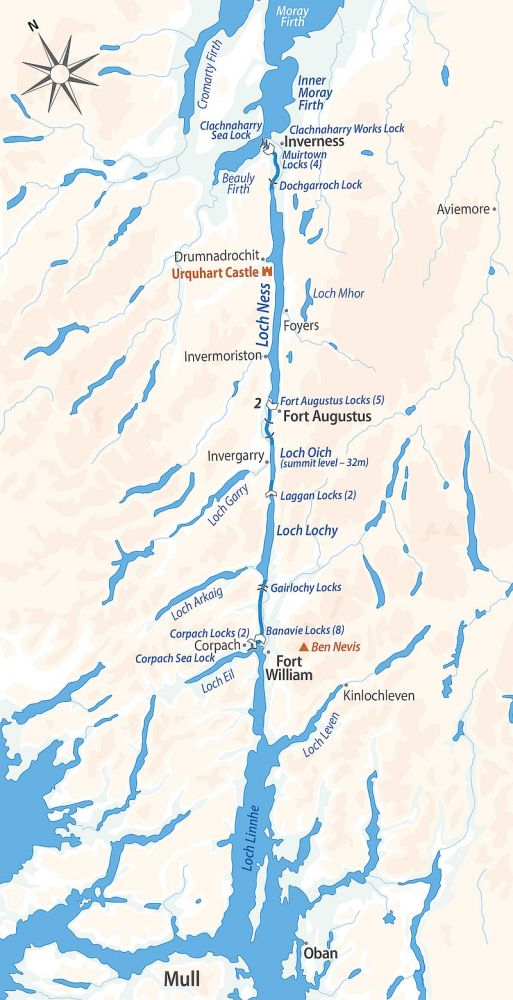
Towns & Villages along the Canal
One of the fastest-growing towns in Europe, Inverness is Scotland’s fifth city as well as being one of the oldest settlements in the Highlands, lying on a strategic position of flat land between the head of the Great Glen and the Moray Firth. Early signs of occupation have been found on Craig Phadrig, a wooded hill to the west of the River Ness and once the site of a Pictish capital. Later, in the 11th century, Macbeth’s castle occupied the site, and although this is another place where Duncan was probably not murdered, his avenging son Malcom Canmore nonetheless burned Macbeth’s wooden stronghold to the ground.
Shortly after this, the first stone structure was built on a bluff to the east, and King David I made Inverness a royal burgh. The castle that occupies the site today, and dominates views of Inverness, was built in 1830 and serves as a courthouse and council offices. In the new-Gothic Town House of 1882, the first British Cabinet Meeting ever half outside London took place in 1921.
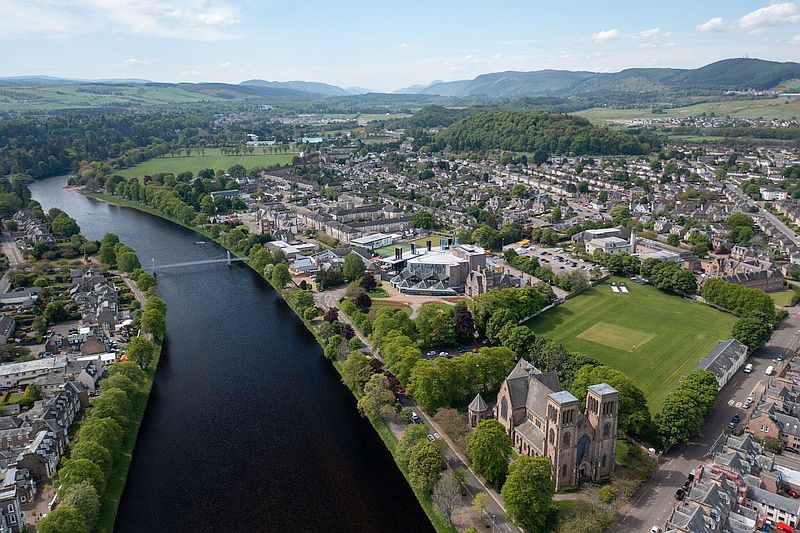
Lying to the west of Inverness, Muirtown is home to the Muirtown Basin. Built as a second harbour for ships on the Caledonian Canal, it unfortunately could not cope with the number of vessels which used its facilities and so never fulfilled its full potential, and today serves as a marina for pleasure craft. Immediately to the south of the basin are the four-lock flight Muirtown Locks and to the north the Muirtown Swing Bridge.
Dochgarroch, a small hamlet that lies at the head of Loch Ness, is home to the newly opened An Talla Visitor’s Centre. Occupying the old Victorian-era village hall, the visitors centre comprises of ticket offices for boat trips on the Caledonian Canal, as well as cafes and shopping outlets. Behind An Talla is Dochfour, a Victorian terraced garden surrounding a historic 18th-century house and home of the Baillie family for over 500 years. Still in private hands, terraced Italianate gardens sweep down to the water’s edge and parkland rises to woodland above the house. In 1881 the gardens were expanded as part of a scheme which routed a railway through the estate.
Invermoriston’s most visited attraction is The Thomas Telford Bridge. Built in 1813, it crosses the spectacular River Moriston falls and used to form part of the main road between Drumnadrochit and Fort Augustus but was replaced in the 1930s with the new bridge used today.
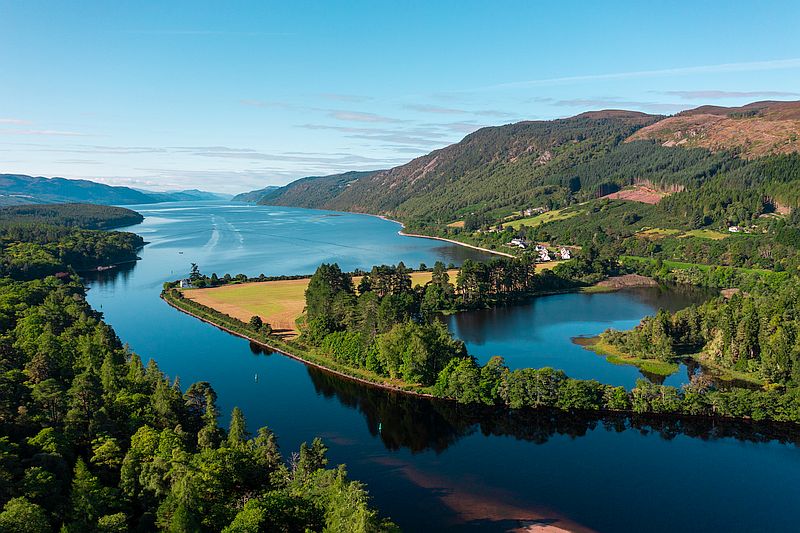
Drumnadrochit grew up around a bridge over the River Enrick and its name, in Gaelic, means “Ridge of the Bridge”. The village today is popular with tourists and backpackers hiking trails to Ben Nevis and Loch Ness.
Fort Augustus is a hamlet located at the southern edge of Loch Ness. It is generally suggested that the original settlement, whose name was Cille Chuimein, was named after Saint Cuumein of Iona, who built a church on the site. In the aftermath of the Jacobite rising in 1715, General Wade built a fort which was named after the Duke of Cumberland. Wade had planned to build a new town around the new barracks and call it Wadesburgh, but as the settlement grew it eventually took the name of the fort. The fort was captured by the Jacobites in March 1746, prior to the Battle of Colluden. In 1867 the fort was sold to the Lovat family and in 1876 it was passed on to the Benedictine Order, who later established Fort Augustus Abbey.
Aberchalder is a small community on the northern end of Loch Oich. The village is named for its location – the prefix “Aber” refers to “the mouth” or “confluence”, while the suffix Chalder translates to “of the calder”. Calder itself is a corruption of Collie Dur, with Collie meaning “off the wood” and Dur used as an obsolete Gaelic term for “water”. The town was owned at one time by Randolph, Earl of Moray, before passing to Dunbar and later to the Clan Fraser of Lovat and later still to Glengarry. A swing bridge is located in the area.
Laggan, a small community in the Great Glen, is located close to the site of The Battle of the Shirts which in July 1544 between the Macdonalds of Rannald and Clan Fraser of Lovat in the Great Glen, overlooking Loch Lochy. The Invergarry and Fort Augustus Railway, which once passed by Laggan opened in 1896, with Invergarry railway station situated at North Laggan. The line closed to passengers in 1933, and to freight in 1947. The Great Glen Way long distance footpath passes by Laggan, running alongside the canal and following the old railway line for some of its 78-mile length.
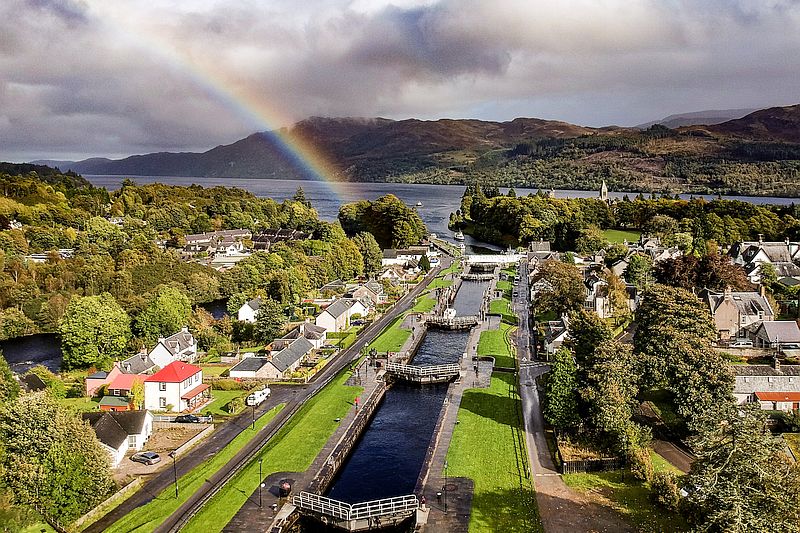
Gairlochy, a tiny settlement of approximately 100 people, is surrounded by several other small crofting settlements, the largest of which is Achnacarry. Close by is Highbridge, the site of the first clash of the 1745 Jacobite uprising. Between 1803 and 1822 the Caledonian Canal was built, passing through the settlement and over the original site of the River Lochy. Two locks were built for access onto Lochy Lochy, but only one, the Upper Lock, is still in use. At the lower lock an end pivoted swing-bridge and lock keepers’ house is provided to carry the road and Great Glen Way over the canal.
Banavie is a small town near Fort William and one of the nearest villages to Ben Nevis. It has been suggested that Banavie is one of the possible birth places of Saint Patrick. The son of a Roman tax collector, the theory suggests he was born at Banavie around 389 AD after his family had come with the Romans, who had invaded the West Highlands and Islands. The place name Bannavem Taburniae is mentioned in one of only two known authenticated letters by the Saint. The scenery around Banavie is exceptional, with Ben Nevis dominant in the skyline. The Caledonian Canal passes through Banavie, before ascending Neptune’s Staircase, the longest lockflight in Britain.
Corpach’s name is Gaelic for “field of corpses” – so called because it was used as a resting place when taking coffins of chieftains on the way to burial on Iona. A large village north of Fort William, Corpach is a natural harbour and during the First World War, the United States Navy had a base at here as part of the laying of the North Sea Mine Barrage. Naval mines were shipped into Corpach from the United States, and were then sent to the Inverness base along the Caledonian Canal, which joins Loch Linnhe at Corpach.
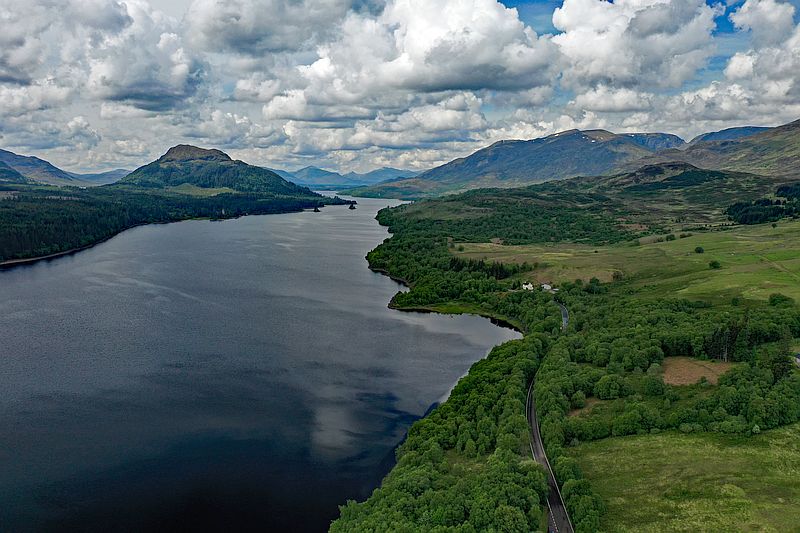
The earliest recorded settlement on the site at Fort William is a Cromwellian wooden fort built in 1654 as a base for English troops to “pacify” Clan Cameron after the Wars of the Three Kingdoms. The post-Glorious Revolution fort was named Fort William after William of Orange, who ordered that it be built to control the Highland clans. In the Jacobite Rising of 1745, known as the Forty-Five, Fort William was besieged for two weeks by the Jacobites. Although the Jacobites had captured both of the other forts in the chain of three Great Glen fortifications (Fort Augustus and Fort George), they failed to take Fort William.
Places to Visit Along the Caledonian Canal
The Battle of Culloden Moor, on April 16th 1746, was the last pitched battle ever to be fought on British soil and marked the end of the Jacobite struggle for the British throne that had started in 1688. Determined to reclaim the throne for his father, Bonnie Prince Charlie, son of James VIII, marched as far south as Derby, before realising that his cause was hopeless and turned home to ultimate defeat at Cullonden.
Perhaps the most infamous and melancholic place in the Scottish Highlands is Glencoe. On the morning of 13 February 1692, a regiment of Campbells, under orders from the Secretary of State for Scotland, the 1st Earl of Stair, fell upon their hosts the Macdonalds and “put all to the sword under seventy”. An estimated 30 members and associates of the MacDonald Clan were killed by the government forces billeted with them, and countless others left to die of exposure in the Winter snows, on the grounds they had not been prompt in pledging allegiance to the new monarchs, William III of England (II of Scotland) and Mary II.
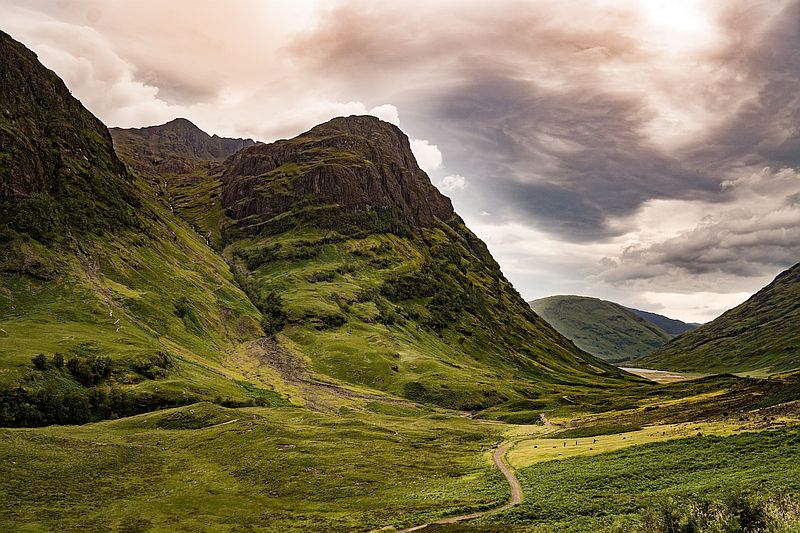
Although, in terms of numbers, this was by no means the worst of the massacres that marked the Highland feuds, the Glencoe Massacre takes on a peculiar notoriety because of the collusion of the Crown and the cold-blooded way the honoured guests committed such heinous “murder under trust”. Glencoe might have been specially designed by nature as the perfect setting for dark and treacherous deeds – even on Summer days it is a grim, forbidding place, a great cleft driven through the black, sullen mountains bereft of warmth or sunlight.
Old Inverlochy Castle is a ruined, 13th century castle near Inverlochy and Fort William. The site of two major battles, the castle is unusual as it remains largely unchanged since its construction during the reign of King Alexander III. Built on the site of an earlier Pictish fortification, the castle was destroyed by Viking forces. Its simple layout comprises a quadrangular courtyard surrounded by a wall up to 2.7m thick and up to 7.6m high, with round towers at each corner. The main entrance was to the south, with a “water gate” facing the river to the north and defended by a portcullis and an interior gatehouse.
Possibly the most photographed monument in Scotland, Eilean Donan is everything an ancient Highland fortress should be. Yet, less than 100 years ago it was nothing more than a pile of stones, having been blown to pieces by Royal Navy warships during the Jacobite uprising of 1719, during a time when it housed a Spanish garrison supporting the Old Pretender. Home of the MacRaes, Eilean Donan was restored at vast expense by Lieutenant-Colonel John MacRae Gilstrap between 1920 and 1932, and has since appeared many times in cinema – most notably the 1986 film Highlander and as the MI6 Headquarters in the 1999 James Bond film The World is Not Enough. One of the best visits along the Caledonian Canal.
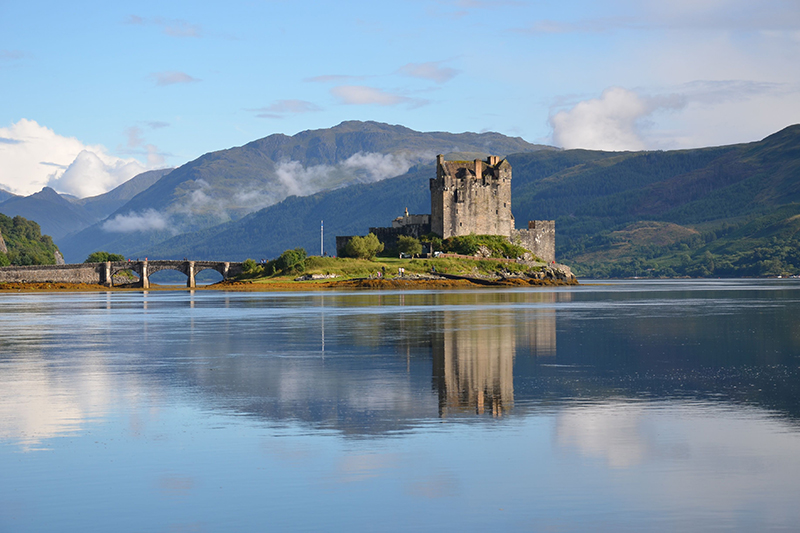
Loch Ness has an average depth of 427 ft and is 22.6 miles in length, making it not only the longest lake in Britain, but also that which holds the greatest volume of water of any lake in Britain, with more water than all the lakes and reservoirs in England put together. Filling the northern half of the Great Glen that divides Scotland, in fair weather the unrivalled beauty of Loch Ness, and its setting, can sometimes disappoint visitors to the Caledonian Canal seeking black, icy waters, lowering mists and monsters. The first person to sight the infamous Loch Ness Monster, or “Nessie”, was St Columba in c.595 while he was travelling north to convert the Pictish King Brude at Craig Phadrig. The modern legend, however, began in 1933 when the Loch became more accessible thanks to roads constructed along the northern bank. A local couple were driving home along the new road, when they were alarmed to see “an enormous animal rolling and plunging on the surface”. The editor of the Inverness Courier chose to headline the story with “monster” and since then, despite hundreds of sightings and photographs, theories and scientific expeditions, no one has been able to prove the monster’s existence.
The romantic ruins of Urquhart Castle sit on the shores of Loch Ness on the site of a much earlier medieval fortification. Founded in the 13th century, Urquhart Castle played an important role in the Wars of Scottish Independence of the 14th century and was subsequently held as a royal castle. Granted to the Grant Clan in 1509, it was raided on several occasions by the MacDonalds and despite being strengthened to defend against the raids the castle was largely abandoned in the mid 17th century. Urquhart was partially destroyed in 1692 to prevent its use by Jacobite forces and subsequently decayed. By the 1770s the castle was roofless and was regarded as a romantic ruin by 19th century painters and visitors to the Highlands. In 1913 the castle was placed in care as a scheduled monument and is today open to the public, being one of the most visited castles in Scotland and a must see on our Caledonian Canal itineraries.

Cawdor Castle is magnificent and moody, with its deep dry moat, brooding square tower, portcullis and the only surviving drawbridge at a private castle in Scotland. Though Macbeth may not have actually killed Duncan here, it feels like the sort of place where he might have done and certainly in much earlier building, for the keep, the oldest part of what we see today, only dates from the 15th century. The original name of the land, and the castle, was Calder and the family were Calders of Ilk. Pronounced Cawdor by the locals, it was by this name that Shakespeare would have heard the castle called when he visited Scotland to research his new play.
Legend has it, when, in the 14th century, a local Thane (an Anglo Saxon nobleman) decided to treat himself to a fortress, he was guided by a dream to load a donkey with a chest of gold, let it go free, and build his castle where the donkey lay down to rest. If he did this, he was told, his family would prosper. The beast wandered for a while before finally resting under a holly tree, and the obedient Thane erected the Keep around the tree and now the ancient holly tree, dead, though still standing, can be seen growing out of the floor of the dungeon and through a hole in the ceiling. Modern science has proven the tree to date from 1372. A must visit when cruising on the Caledonian Canal.
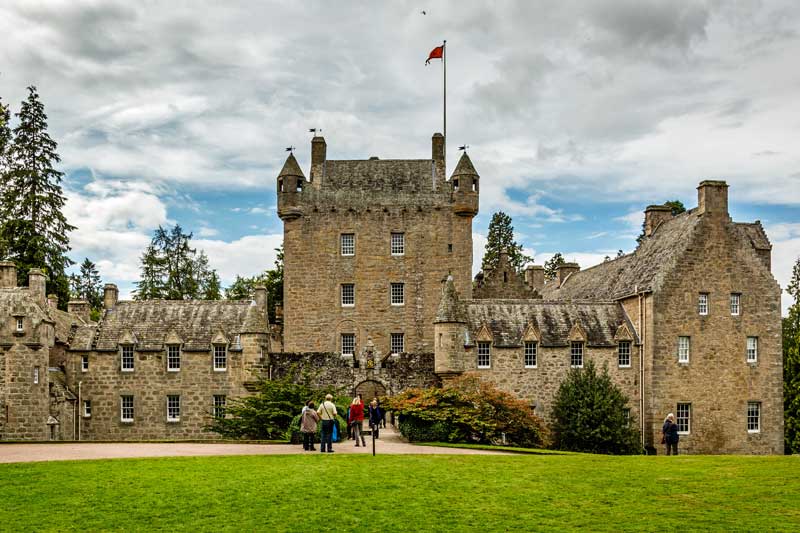
Approximately 50 Bronze Age circular tomb chambers have been discovered, with those in the best state of preservation at Balnuaran of Clava to the east of Inverness.
Fort George is a large 18th century fortress near Ardersier, built to control the Scottish Highlands in the aftermath of the Jacobite Rising of 1745. Based on a star design, the fortress has never been attacked and remains virtually unaltered, continuously in use as a garrison. Work on the fortresses started in 1748 and by 1757 the main defences were in place before being finished in 1769. Though the barracks are still in use as a military establishment, the site is open to the public with various exhibits and reproductions showing the fort’s use at different periods.
On the afternoon of Monday, August 19th 1745, Bonnie Prince Charlie stepped out of a small rowing boat at Glenfinnan, at the head of Loch Shiel. A troop of 50 MacDonalds were awaiting him and, while the Prince took shelter in a barn, more MacDonalds, Camerons and MacDonndells arrived, swelling his ranks to some 1,300 men. Charles climbed today to top of one of the smaller hills and raised his father’s standard, gave a small speech and distributed brandy all round. The Glenfinnan Monument, commemorating the event, was erected in 1815 and is now in the care of the National Trust for Scotland. The statue at the stop of the monument is not of Bonnie Prince Charlie himself, but represents instead all the Highland clansmen who gathered there to fight in 1745.
Overlooking the shores of Loch Shiel and the Glenfinnan Monument is the Glenfinnan Viaduct, which carries the West Highland Line between Fort William and Mallaig. Built in 1897, the viaduct comprises of 21 arches over the River Finnan and has features in several films, most notably Harry Potter. This is a popular visit for families when cruising the Caledonian Canal.
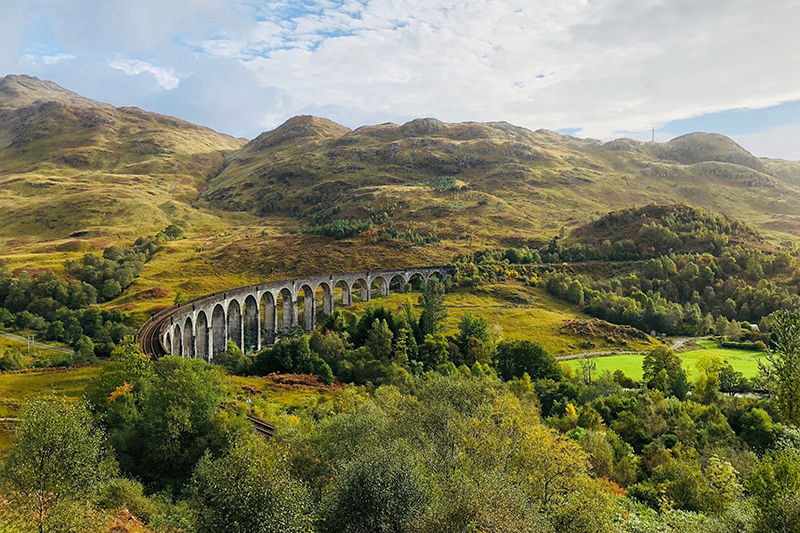
Inveraray Castle was the first major neo-gothic castle to be built in Britain. Home to the chief of one of Scotland’s most powerful clans, the Campbells, Dukes of Argyll. The second Duke was one of the British Army’s first two field marshals and the fifth Duke was said to have been married to one of the Gunnings sisters, who were considered to be the most beautiful women in Europe. Its State Dining Room, completed in 1784, is said to be the finest painted room in Britain, as well as the only surviving work anywhere of the French painters Girard and Guinard.
Dunrobin Castle is one of the most extraordinary sights in Scotland; a vast, flamboyant fairy castle of pinnacles and turrets set high on a cliff overlooking the North Sea. Hidden within all this extravagance is the ancient 13th century seat and one of the oldest continuously inhabited houses in Britain. The Earldom of Sutherland dates back to 1235, when the Scottish Kings took these northern lands back from the Norse and scattered titles and territories to their friends and supporters.
The original keep was built in 1275 and was added to over the centuries, mainly during the reign of Charles II in the 18th century. The ocean-facing façade that greets the world today was designed by the architect Sir Charles Barry, of Houses of Parliament fame. Barry also laid out the formal gardens, which were inspired by those at Versailles and remain virtually unchanged since they were created.
The castle has 189 rooms and is the most northerly of Scotland’s great houses and is the largest residence in the northern highlands. The upper floors are said to be haunted by the daughter of the 14th Earl, who fell to her death climbing from an attic window while attempting to elope.
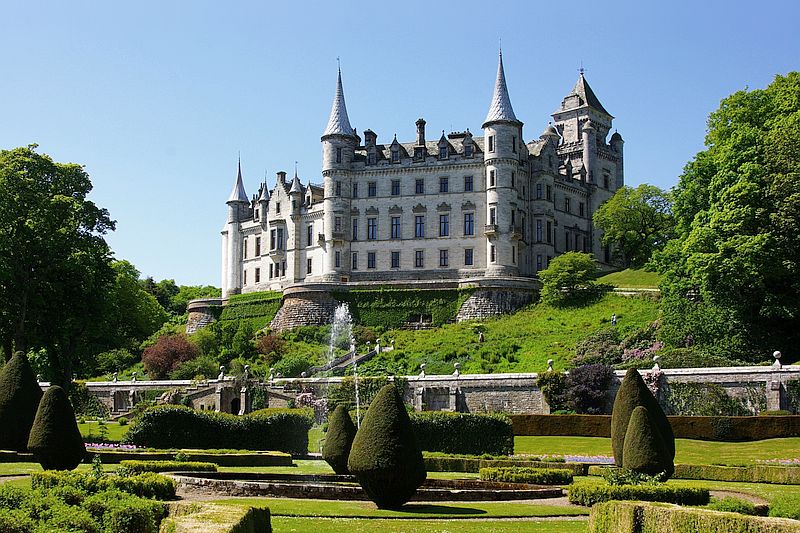
Brodie Castle, originally in a Z-plan, was built in 1567 by the Brodie Clan but was destroyed by a fire in 1645 by the Gordon Clan. In 1824 the architect William Burn was commissioned to convert the ruins into a large mansion house in the Scots Baronial style, but these additions were never completed and were later remodelled by James Wilson in circa 1845. The Brodie family called the castle home until the early 21st century, and it is widely acknowledged that the Brodies had been associated with the area since the 12th century when the land was given to them by King Malcom IV. Since 2017, the castle and its surrounding gardens have been owned by the National Trust for Scotland and its interiors have been well preserved, containing fine antique furniture, oriental artefacts and painted ceilings dating from the 17th-19th centuries.
The land around Beauly is very fertile, and, historically, corn was grown extensively in the area, though today fruit has successfully been farmed. The town is the site of the Priory Church of the Blessed Virgin and John the Baptist, also known as Beauly Priory, which was founded in 1230 by John Byset of the Aird for Valliscaulian monks. Following the Reformation, the buildings, except for the church (which is now a ruin) passed into the possession of Lord Lovat. 77 76
Beaufort Castle, near Beauly, is a Baronial style mansion built in 1880 incorporating older building work, situated on the right bank of the River Beauly. The traditional seat of the Lords Lovat, there has been a castle of the site since the 12th century. In 1815 the estate was inherited by Thomas Fraser of Steichen, who was reinstated to the Lordship of Lovat in 1854, and commissioned William Burn to extend the house, and also improve the grounds and surrounding estate. His son, Simon Fraser, the 13th Lord Lovat, built the present Beaufort Castle to designs by James Maitland Wardrop, incorporating part of the 18th century house. In 1994 the castle was sold to Anne Gloag, director of the transport group Stagecoach.
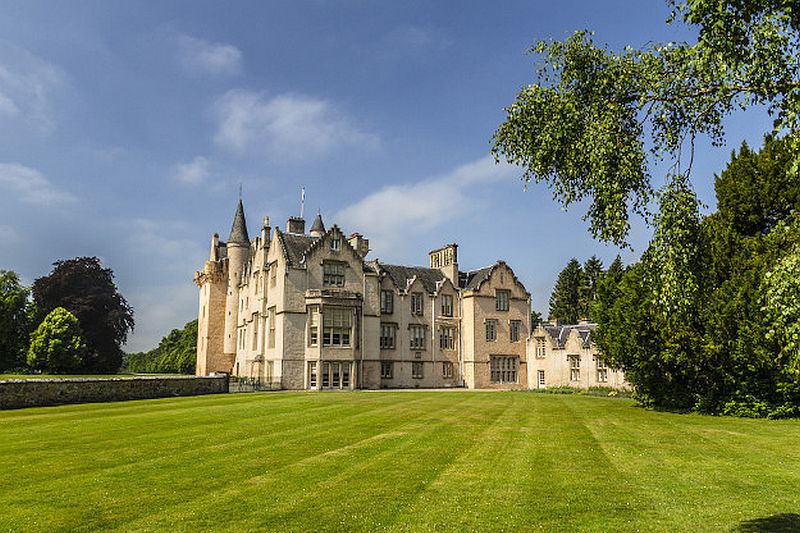
On a windswept plateau above Spean Bridge is the striking Commando Memorial, unveiled by the late Queen Mother in 1952. In the Summer of 1940, during Britain’s darkest hour, Prime Minister Winston Churchill called for the raising of an elite force of men to take on the axis powers in Europe and regain the initiative for Britain. Only the best fighting men earned the right to wear the Commandos’ green beret and the enemy soon learned to fear them. Their motto was “United We Conquer”. Their training ground was here in the rugged terrain of Inverness-shire.
The Commando unit was made up of only the best British soldiers during the Second World War The Highland Folk Museum is an open-air museum and visitor attraction in the Highlands. Its origins can be tracked back to 1930, when Dr Isabel Frances Grant organised and curated the Highland Exhibition in Inverness, in which more than 2,100 artefacts were exhibited as a “national folk museum”. She founded the subsequent Highland Folk Museum five years later, using a personal legacy to acquire a disused former United Free Church on the island of Iona. The museum today is primarily made up of three areas that represent and interpret three separate eras of the Scottish Highlands. Each area is also interpreted by a staff member dressed, and performing, as a Highlander and on certain days throughout the year the museum features demonstrations of highland life activities, such as weaving or rope making.
Ready to Explore the Caledonian Canal?
Guests who cruise the Caledonian Canal aboard luxury hotel barges Spirit of Scotland and Scottish Highlander will have the opportunity to visit many of the sites listed above. For more information on our Caledonian Canal itineraries and the rest of our collection of luxury hotel barge cruises, why not order a free copy of our brochure today or speak to a member of our team directly using our handy Contact Form.
 English
English
 Spanish
Spanish French
French German
German Norwegian
Norwegian Portuguese
Portuguese Swedish
Swedish Italian
Italian Russian
Russian Simplified Chinese
Simplified Chinese Japanese
Japanese